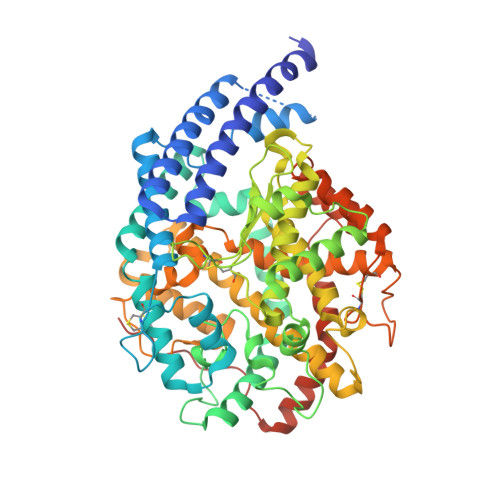Crystal structures of angiotensin-converting enzyme from Anopheles gambiae in its native form and with a bound inhibitor.
Cashman, J.S., Cozier, G.E., Harrison, C., Isaac, R.E., Acharya, K.R.(2019) Biochem J 476: 3505-3520
- PubMed: 31682720
- DOI: https://doi.org/10.1042/BCJ20190635
- Primary Citation of Related Structures:
6S1Y, 6S1Z - PubMed Abstract:
The mosquitoes of the Anopheles and Aedes genus are some of the most deadly insects to humans because of their effectiveness as vectors of malaria and a range of arboviruses, including yellow fever, dengue, chikungunya, West Nile and Zika. The use of insecticides from different chemical classes is a key component of the integrated strategy against An. gambiae and Ae. aegypti, but the problem of insecticide resistance means that new compounds with different modes of action are urgently needed to replace chemicals that fail to control resistant mosquito populations. We have previously shown that feeding inhibitors of peptidyl dipeptidase A to both An. gambiae and Ae. aegypti mosquito larvae lead to stunted growth and mortality. However, these compounds were designed to inhibit the mammalian form of the enzyme (angiotensin-converting enzyme, ACE) and hence can have lower potency and lack selectivity as inhibitors of the insect peptidase. Thus, for the development of inhibitors of practical value in killing mosquito larvae, it is important to design new compounds that are both potent and highly selective. Here, we report the first structures of AnoACE2 from An. gambiae in its native form and with a bound human ACE inhibitor fosinoprilat. A comparison of these structures with human ACE (sACE) and an insect ACE homologue from Drosophila melanogaster (AnCE) revealed that the AnoACE2 structure is more similar to AnCE. In addition, important elements that differ in these structures provide information that could potentially be utilised in the design of chemical leads for selective mosquitocide development.
Organizational Affiliation:
Department of Biology and Biochemistry, University of Bath, Claverton Down, Bath BA2 7AY, U.K.

















